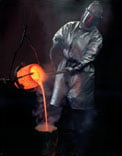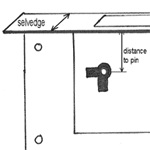Glossary of Terms
Below you will find our common vocabulary we use to describe our antique furniture hardware. Some words you may have heard before on other sites, and some are unique to our shop.
Terms for Furniture Hardware

Bail
The hanging brass handle itself that swings on a drawer pull.
Bail Pull
A drawer pull with a bail handle which swings from the two posts.
Back Plate
The circular or curved brass plate that sits against the wood. Back plates are sometimes called escutcheons.
Boring
The center to center distance between the posts of a drawer pull. Some borings are in bold text. These borings are best in terms of balance and proportion for a given pull. Unless you are fitting existing holes on the furniture consider using the boring in bold.
Escutcheon
Tricky term. To some antique experts, escutcheon refers to any flat or curved metal plate. In common usage it refers to a plate with a keyhole in it. 
Posts
Drawer pulls have two posts holding the bail. Ring pulls have one post with a ring attached.
Machine Screw Fitting (MSF)
A machine screw is a round headed, threaded, slotted bolt. The machine screw fitting mounts a drawer pull by putting a machine screw through the hole from the inside. This screws into an internally threaded post. With this installation, nothing protrudes into the drawer.
Solid Brass
All drawer pulls and knobs are solid brass. With the exception of our upholstery tacks, which are steel for strength, none of our hardware is brass plated.
General Glossary
Back Bevel
Sometimes called chamfering-cutting a back bevel means taking an edge off. We refer to back beveling as a process on a cabinet door. To use a non-mortise hinge effectively you will need to back bevel the hinge side of the door 2 or 3 degrees to allow the hinges to work properly. Please contact us if you have any questions.
Cast Brass
Casting is a many centuries old process that involves liquefying metal and then pouring it into molds. In the case of brass, the metal is heated to around 2000 degrees in a ceramic crucible (like a giant bowl) in a gas fired furnace. In our foundry, the crucible holds about 85lbs. The crucible is put into a metal frame and supported by overhead tracks. Two people pour it by tipping it forward and quickly filling a small hole in the molds as fast as possible to get the maximum pressure. This process is very dramatic, and the metal is quite beautiful-much like molten lava. It is also the most dangerous work we do, and those involved wear fire resistant suits like fireman do and breathing gear. The photo from the cover of our old catalog shows this process quite accurately.
Finishes
Most hardware is available in your choice of antique brass, semi-bright brass, dark antique, and polished brass. Some kitchen hardware is available in polished nickel and satin nickel. Read more about our finishes.
Japanned
Jappaning is a black lacquer that is applied to surfaces and presents a glossy finish. We use it on our straight cupboard locks.
Measure boring
Boring is the distance between post holes on a drawer. This distance is measured from the center of one hole to the center of the other hole. Careful measurement is important. If you are replacing existing hardware, measure the boring and then select the replacement hardware that is available in that boring from the boring chart. If you are ordering hardware for new furniture, select the ideal boring, shown in bold print in the list of available borings next to each item. If you are selecting hardware for a curved drawer front, please tell us. Sometimes we will give you special posts or advice about installing your hardware that is specific to your situation.
Dimensions
Overall dimensions are provided for most of our products. The first measure given is always the horizontal dimension (width), and the second measurement is always the vertical dimension (height). Please feel free to call if we can provide additional information. Actual size tracings are available for Chippendale patters, and we can always photocopy a backplate to help you decide. These services are especially useful if you need to cover marks on the wood.
Selvedge
The selvedge of a lock is the part that wraps around the edge of the door or drawer.
Style
A style is the thin piece of wood that separates the doors on cabinets where two doors close together.
Whitesmithing
A process where all of the scale that comes from forging is hand filed and removed, leaving a whitish, silvery, pewter-like finish. Most of our iron is sold in a black iron finish, but some padlocks and hasps are available in the whitesmithed finish. Read more about our finishes. |